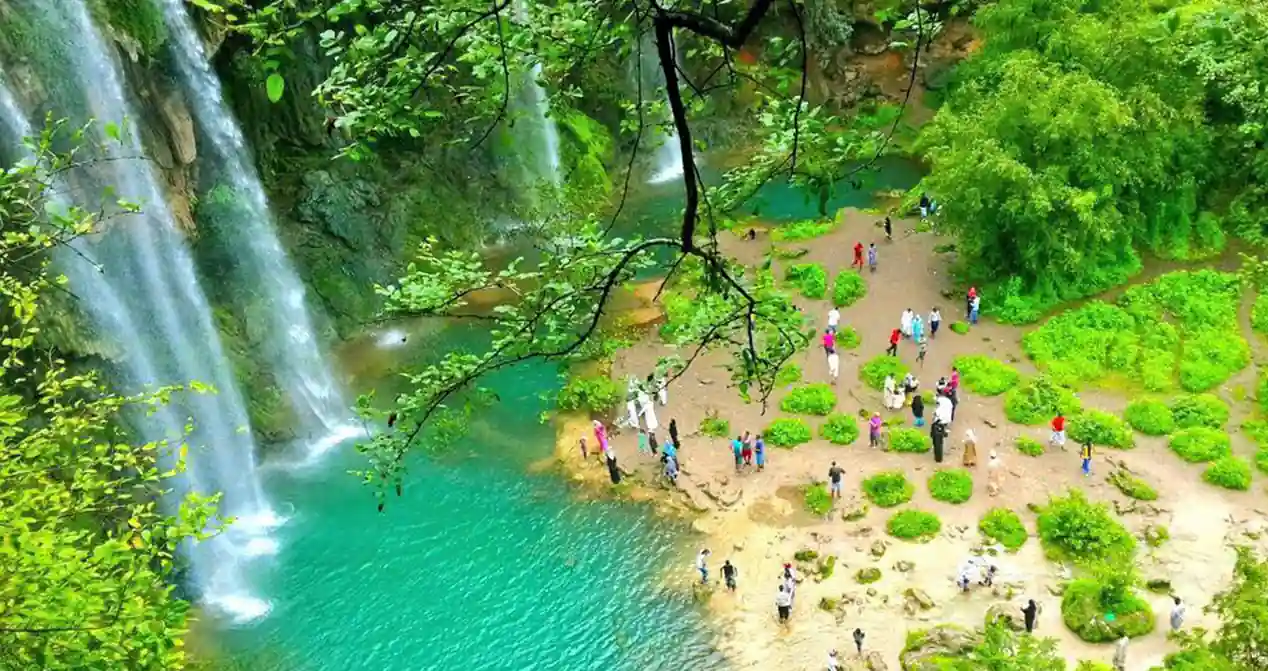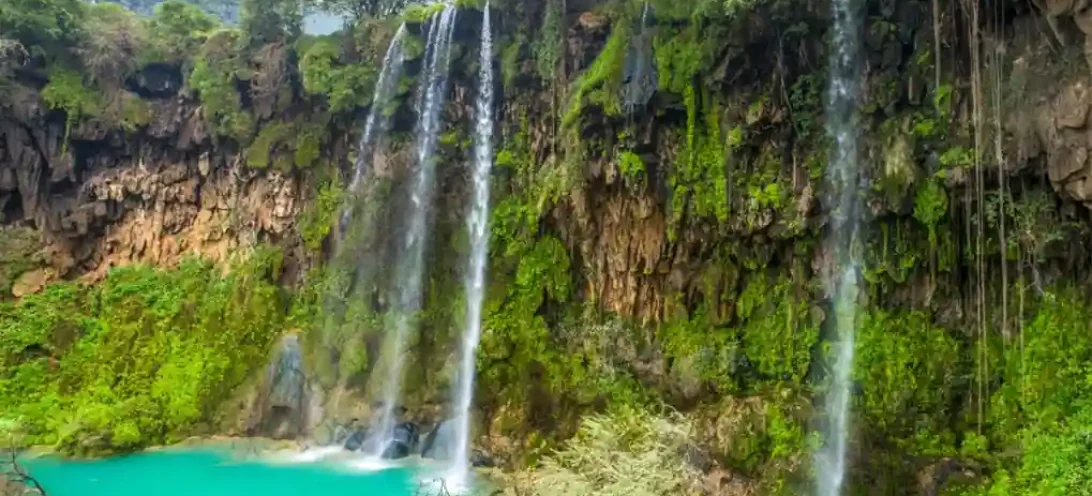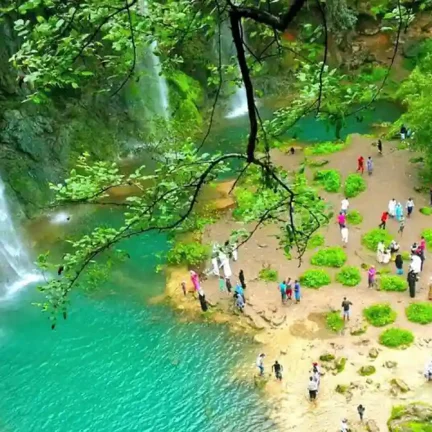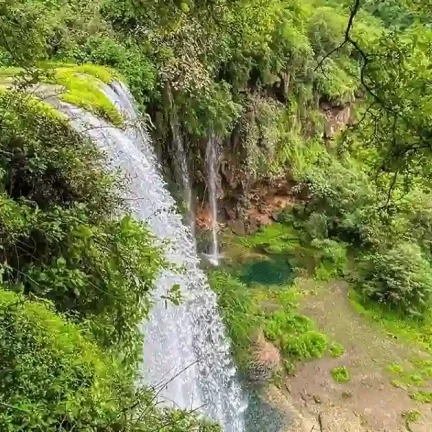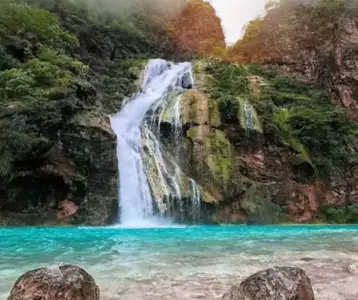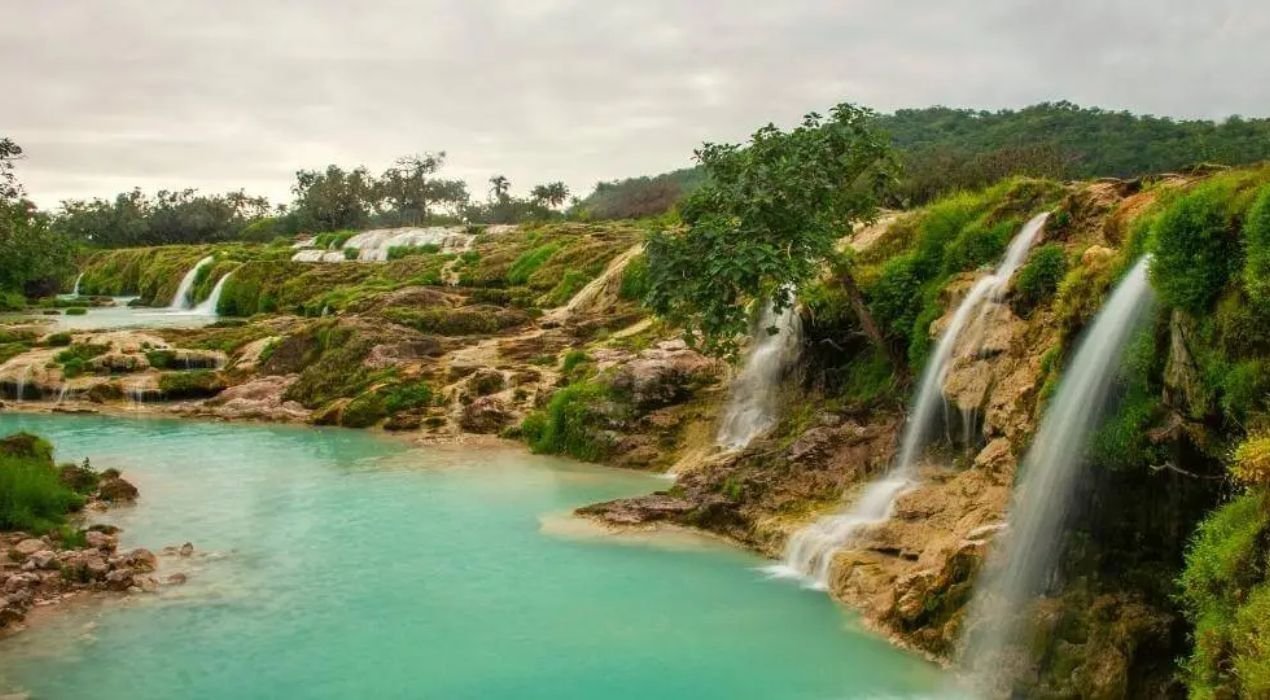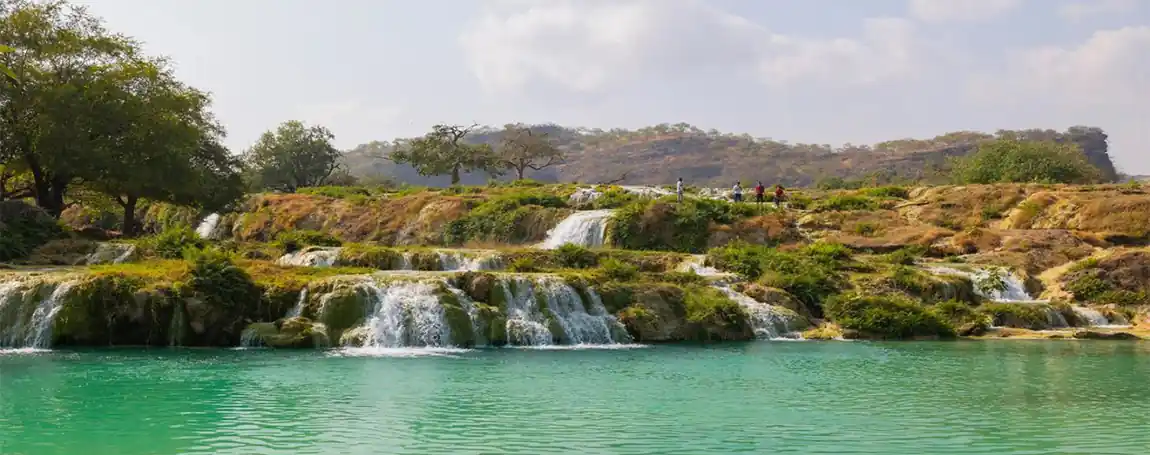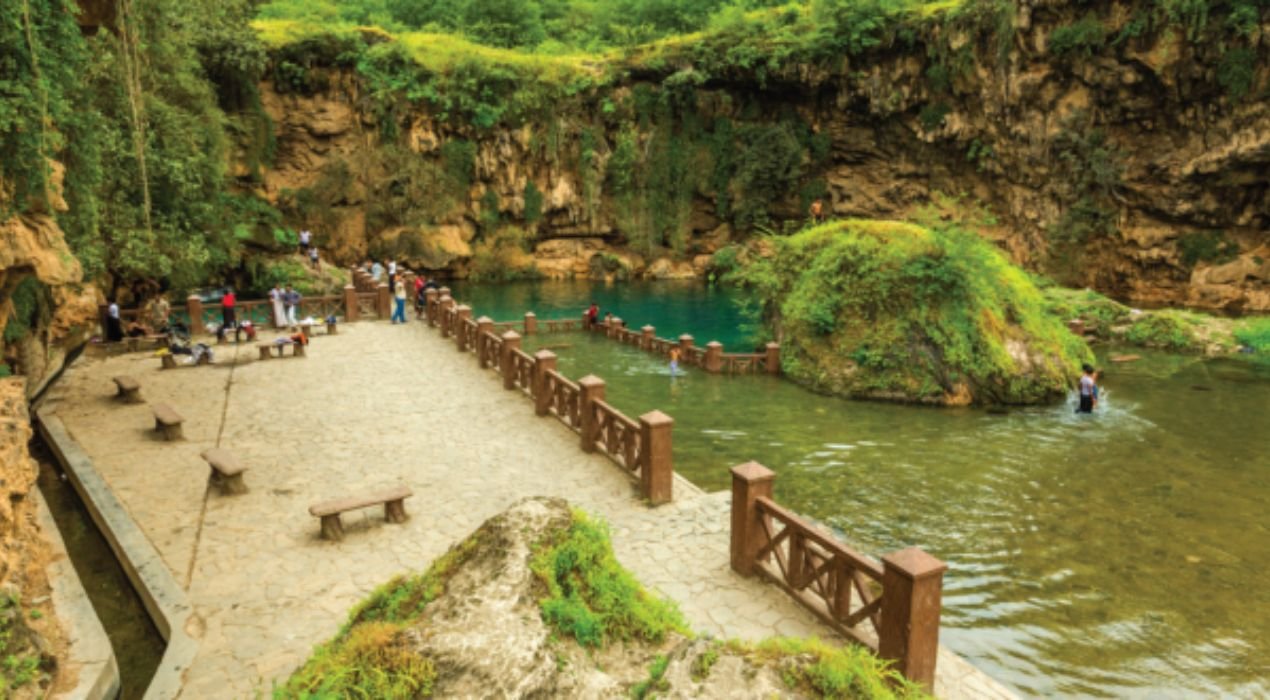The Enchanting Ayn Athum Waterfall
Ayn Athum stands as a testament to the raw beauty of Oman’s diverse landscape. This seasonal waterfall, tucked away in the Jabal Qara mountain range, comes to life during the Khareef season, transforming the arid terrain into a verdant oasis. The cascade, measuring approximately 15 meters in height, creates a stunning display as water tumbles down limestone cliffs, forming intricate patterns and nourishing the surrounding ecosystem.
1. A Seasonal Spectacle
The ephemeral nature of Ayn Athum adds to its allure, making it a prized destination for those who time their visits just right. Typically visible only in July and August, the waterfall’s appearance depends entirely on the intensity of the monsoon rains. This fleeting quality creates a sense of anticipation and excitement among visitors, who eagerly await the moment when the parched landscape gives way to flowing streams and misty falls.
2. Geological Marvel
The formation of Ayn Athum is a result of complex geological processes. Over millennia, rainwater has carved through the limestone bedrock, creating a natural channel that springs to life during the wet season. The porous nature of the limestone allows water to percolate through the rock, emerging as a gushing torrent when conditions are right. This interplay between rock and water has sculpted a breathtaking natural amphitheater that serves as the backdrop for the waterfall.
3. Flora and Fauna
The seasonal abundance of water transforms the area around Ayn Athum into a thriving ecosystem. During the Khareef, the landscape bursts into life, with a carpet of lush greenery covering the normally barren ground. Delicate maidenhair ferns cling to the damp rock faces, while hardy succulents and vibrant wildflowers add splashes of color to the scene. This temporary oasis attracts a variety of wildlife, from nimble mountain gazelles to colorful butterflies and a diverse array of bird species.
The Khareef Season: Nature's Grand Performance
The Khareef, or monsoon season, is the lifeblood of the Dhofar region, bringing with it a dramatic transformation of the landscape. This annual phenomenon, typically lasting from late June to mid-September, turns the coastal plains and mountains into a lush, green paradise that stands in stark contrast to the rest of the Arabian Peninsula.
1. Understanding the Monsoon
The Khareef is a unique weather pattern that affects the southern coast of Oman. As warm, moisture-laden air from the Indian Ocean meets the cooler air over the Dhofar Mountains, it creates a blanket of mist and drizzle that envelops the region. This persistent light rain, combined with cooler temperatures, creates ideal conditions for the emergence of seasonal waterfalls like Ayn Athum.
2. Impact on Local Climate
During the Khareef, temperatures in Salalah and the surrounding areas drop significantly, often hovering around 25°C (77°F). This cool respite from the scorching summer heat of the Gulf region makes Dhofar a popular destination for tourists seeking relief from the sweltering temperatures elsewhere in the Middle East.
3. Agricultural Significance
The monsoon rains play a crucial role in supporting local agriculture. The increased moisture allows for the cultivation of crops that would otherwise be impossible in the arid climate. Traditional frankincense trees, for which the region is famous, thrive during this period, their roots drinking deeply from the saturated soil.
Planning Your Visit to Ayn Athum
To fully appreciate the beauty of Ayn Athum, careful planning is essential. Given its seasonal nature and remote location, visitors should consider several factors to ensure a memorable and safe experience.
1. Best Time to Visit
The optimal window for viewing Ayn Athum is typically between mid-July and late August, when the Khareef is at its peak. However, the exact timing can vary from year to year depending on rainfall patterns. It’s advisable to check local weather reports and consult with tour operators or local guides for the most up-to-date information on the waterfall’s status.
2. Getting There
Ayn Athum is located approximately 30 kilometers east of Salalah city. The journey takes about 25-30 minutes by car, following a scenic route through the Dhofar Mountains. While the road is generally well-maintained, a 4×4 vehicle is recommended, especially during the wet season when conditions can be slippery.
3. Guided Tours vs. Independent Travel
For first-time visitors, joining a guided tour can be an excellent way to experience Ayn Athum. Local operators offer half-day and full-day excursions that often include transportation, expert guides, and sometimes even picnic lunches. These tours can provide valuable insights into the region’s geology, flora, and fauna.
For more adventurous travelers, independent exploration is possible. However, it’s crucial to be well-prepared with appropriate gear, plenty of water, and a reliable map or GPS device. Always inform someone of your plans before setting out, as mobile phone coverage can be spotty in remote areas.
4. What to Bring
When visiting Ayn Athum, it’s important to come prepared. Essential items include:
- Sturdy, waterproof hiking shoes
- Light, breathable clothing (with layers for cooler temperatures)
- Sun protection (hat, sunscreen, sunglasses)
- Insect repellent
- Plenty of water and snacks
- Camera or smartphone for capturing memories
- Small first aid kit
- Waterproof bag for electronics
Activities and Experiences at Ayn Athum
The area surrounding Ayn Athum offers a wealth of activities for nature lovers and adventure enthusiasts. From serene hikes to adrenaline-pumping experiences, there’s something for every type of traveler.
1. Hiking and Nature Walks
The trails leading to and around Ayn Athum provide excellent opportunities for hiking and nature walks. As you traverse the lush landscape, you’ll encounter a diverse array of plant life and possibly catch glimpses of local wildlife. The relatively gentle terrain makes these walks suitable for most fitness levels, though some areas may be slippery during the wet season.
2. Photography
Ayn Athum is a photographer’s paradise, offering countless opportunities to capture stunning landscapes and macro shots of the unique flora. The interplay of light and mist creates magical conditions, especially during the early morning or late afternoon golden hours. Be prepared for challenging lighting conditions and bring appropriate gear to protect your equipment from moisture.
3. Picnicking
The serene environment around Ayn Athum makes for an ideal picnic spot. Many visitors choose to bring a packed lunch and spend a leisurely afternoon enjoying the cool mist and soothing sounds of the waterfall. However, it’s crucial to practice Leave No Trace principles and take all trash with you when departing.
4. Bird Watching
The Khareef season attracts a variety of bird species to the area, making Ayn Athum a prime location for bird watching. From resident species to migratory visitors, keen-eyed observers may spot Arabian partridges, Eurasian hoopoes, or even the elusive Verreaux’s eagle.
5. Cultural Significance of Ayn Athum
Beyond its natural beauty, Ayn Athum holds cultural importance for the local Dhofari people. The waterfall and its surrounding area have been integral to the traditional way of life in the region for centuries.
6. Traditional Uses
Historically, the seasonal springs and waterfalls of Dhofar, including Ayn Athum, have been crucial water sources for local communities and their livestock. During the dry months, knowledge of these hidden water sources was vital for survival in the harsh desert environment.
7. Folklore and Legends
Like many natural landmarks in Oman, Ayn Athum features in local folklore. Stories passed down through generations often attribute magical properties to the waterfall, with some tales speaking of jinns (supernatural creatures in Arabian mythology) that guard the waters.
8. Modern Cultural Importance
Today, Ayn Athum serves as a symbol of Dhofar’s unique identity within Oman. The waterfall and the Khareef season it represents are celebrated in local poetry, art, and music, embodying the region’s connection to nature and its seasonal rhythms.
Customize your Trip With Go Safari Salalah
Are our Salalah City Tour places not fulfilling enough? Contact us and tailor a city tour to your aspirations and desires.
Conservation Efforts and Sustainable Tourism
As Ayn Athum gains popularity among tourists, efforts to preserve its natural beauty and ecological integrity have become increasingly important. Various stakeholders, including government agencies, local communities, and environmental organizations, are working together to ensure sustainable tourism practices.
1. Environmental Protection Measures
The Omani government has implemented several measures to protect the fragile ecosystem around Ayn Athum. These include:
- Designated walking trails to minimize erosion and protect vegetation
- Strict regulations on waste disposal and littering
- Limits on visitor numbers during peak seasons
- Educational programs to raise awareness about the area’s ecological importance
2. Community Involvement
Local communities play a crucial role in conservation efforts. Many residents serve as guides or work in eco-tourism, providing them with economic incentives to protect the natural environment. Community-led initiatives, such as clean-up campaigns and tree-planting programs, contribute to the long-term sustainability of the area.
3. Responsible Tourism Practices
Visitors to Ayn Athum are encouraged to practice responsible tourism. This includes:
- Staying on designated trails
- Avoiding the removal of plants or rocks
- Properly disposing of waste
- Respecting wildlife and maintaining a safe distance
- Supporting local businesses and guides
Beyond Ayn Athum: Exploring Dhofar
While Ayn Athum is undoubtedly a highlight, the Dhofar region offers many other attractions worth exploring. Visitors can extend their stay to experience the rich cultural and natural diversity of southern Oman.
1. Salalah City
The nearby city of Salalah serves as an excellent base for exploring the region. Known for its pristine beaches, historical sites, and vibrant souqs (traditional markets), Salalah offers a blend of modern amenities and traditional Arabian charm.
2. Other Natural Wonders
Dhofar boasts several other impressive natural attractions, including:
- Wadi Darbat: A lush valley with a seasonal waterfall and lake
- Al Mughsail Beach: Famous for its blowholes and dramatic coastal scenery
- Empty Quarter (Rub’ al Khali): The world’s largest sand desert, accessible from Dhofar
3. Historical and Archaeological Sites
History buffs will appreciate the region’s rich heritage, evident in sites such as:
- Al Baleed Archaeological Park: Ruins of the ancient port city of Zafar
- Sumhuram: Remains of a frankincense trading outpost
- Nabi Ayoub’s Tomb: A pilgrimage site associated with the Prophet Job
Practical Information for Visitors
To ensure a smooth and enjoyable visit to Ayn Athum and the surrounding area, consider the following practical tips:
1. Accommodation Options
Salalah offers a range of accommodation options to suit various budgets and preferences. From luxury beach resorts to budget-friendly guesthouses, visitors can find comfortable lodging within easy reach of Ayn Athum and other attractions.
2. Transportation
While rental cars are widely available and offer flexibility, many visitors opt for organized tours or hire a local driver familiar with the terrain. During the Khareef season, road conditions can be challenging, so choosing appropriate transportation is crucial.
3. Local Customs and Etiquette
Visitors should be mindful of local customs and dress codes, especially when visiting rural areas or religious sites. Modest dress is appreciated, and it’s important to ask permission before photographing local people.
4. Health and Safety
While Oman is generally a safe country for travelers, it’s advisable to take standard precautions:
- Purchase comprehensive travel insurance
- Stay hydrated and protect yourself from the sun
- Be cautious when hiking, especially during wet conditions
- Respect local wildlife and avoid approaching unfamiliar animals
The Future of Ayn Athum and Dhofar Tourism
As Oman continues to develop its tourism sector, the Dhofar region, including Ayn Athum, is likely to see increased visitor numbers in the coming years. This growth presents both opportunities and challenges for the area.
1. Sustainable Development Plans
The Omani government has outlined plans for sustainable tourism development in Dhofar, aiming to balance economic growth with environmental conservation. These plans include:
- Improved infrastructure to handle increased tourism
- Investment in eco-friendly accommodations and activities
- Enhanced visitor education programs
- Support for local communities to benefit from tourism
2. Potential Challenges
As Ayn Athum gains popularity, managing visitor impact will be crucial. Potential challenges include:
- Overcrowding during peak seasons
- Strain on local resources and infrastructure
- Potential disturbance to wildlife and ecosystems
- Maintaining the authentic cultural experience
3. Opportunities for Eco-Tourism
The unique seasonal nature of Ayn Athum and the Khareef presents opportunities for innovative eco-tourism initiatives. These could include:
- Specialized photography tours
- Scientific expeditions and research programs
- Cultural exchange programs with local communities
- Seasonal festivals celebrating the region’s natural phenomena
Conclusion
Ayn Athum stands as a testament to the raw beauty and seasonal magic of Oman’s Dhofar region. This hidden gem, with its ephemeral waters and lush surroundings, offers visitors a rare glimpse into a landscape transformed by the monsoon rains. As we’ve explored, the waterfall is not just a natural wonder but a cultural touchstone, deeply intertwined with the history and traditions of the Dhofari people.
For those fortunate enough to witness Ayn Athum in full flow, the experience is truly unforgettable. The cool mist, the thundering waters, and the vibrant green landscape create a sensory experience that stands in stark contrast to the typical image of the Arabian Peninsula.
As Oman continues to develop its tourism sector, places like Ayn Athum will play an increasingly important role in showcasing the country’s diverse natural heritage. The challenge moving forward will be to balance increased visitor access with the need to preserve the delicate ecosystems and authentic cultural experiences that make this region so special.
Whether you’re an adventure seeker, a nature lover, or simply someone looking to experience the unique wonders of the Arabian Peninsula, Ayn Athum and the surrounding Dhofar region offer a wealth of experiences. By approaching your visit with respect for the environment and local culture, you can play a part in ensuring that this natural wonder remains a source of beauty and inspiration for generations to come.

